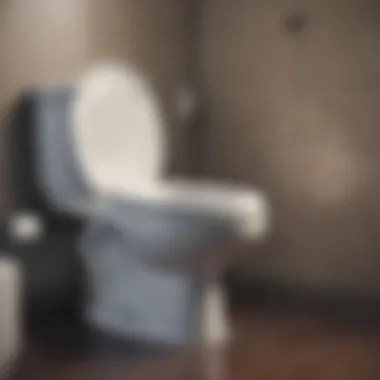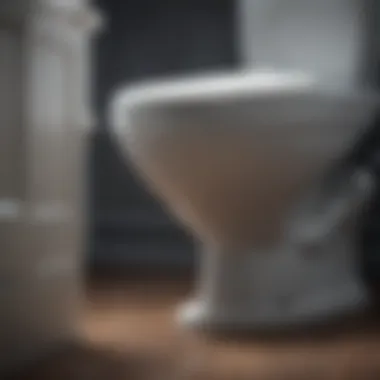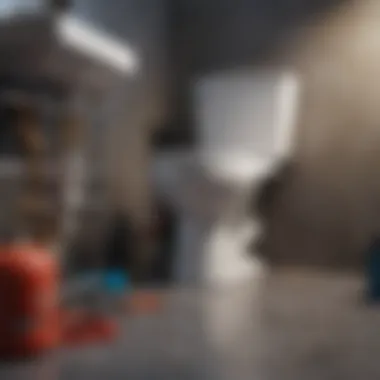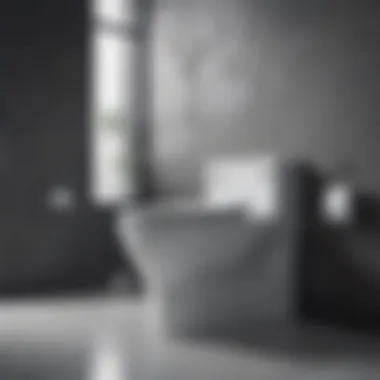Expert Guide to Resolving Toilet Water Drainage Issues Without Clogs


Water in the toilet not draining properly even when there is no visible blockage is a common issue that can be perplexing and inconvenient. This guide aims to delve into the potential reasons behind this occurrence and provide practical solutions to rectify the problem effectively.
Possible Causes of Water Not Going Down in Unclogged Toilets
When faced with the puzzling situation of toilet water not draining despite the absence of any obvious obstructions, several factors could be at play. It is essential to examine the water flow, flushing mechanisms, and plumbing connections to pinpoint the root cause of the drainage problem. From faulty flapper valves to inadequate water levels, a thorough investigation is crucial to resolving the issue.
Faulty Flapper Valve
One common culprit behind water not going down in unobstructed toilets is a malfunctioning flapper valve. The flapper valve is responsible for regulating the release of water into the bowl during flushing. If the valve is damaged or improperly seated, it may disrupt the flushing process, leading to inefficient drainage.
Low Water Level
Insufficient water levels in the toilet tank can also impede proper drainage. Inadequate water volume during flushing can result in weak or incomplete expulsion of waste, causing water to linger in the bowl. Adjusting the fill valve to ensure optimal water levels is essential for facilitating smooth drainage.
Blocked Rim Jets
Clogged rim jets, which are small holes located under the toilet bowl's rim, can hinder the flow of water during flushing. Accumulated mineral deposits or debris in these jets can obstruct the water pathway, preventing effective waste removal. Thoroughly cleaning the rim jets to remove any obstructions is vital for enhancing water evacuation.
Implementing Solutions for Efficient Water Drainage
After identifying the potential causes of water accumulation in unclogged toilets, implementing targeted solutions is necessary to restore optimal functionality. From repairing faulty components to conducting thorough cleaning procedures, taking decisive action is pivotal for resolving the drainage issue.
Repairing or Replacing the Flapper Valve
Addressing a malfunctioning flapper valve involves inspecting its condition and functionality. Repairing minor issues, such as misalignments or seal damage, can restore proper water flow during flushing. In cases of irreparable damage, replacing the flapper valve with a new, compatible component is essential for ensuring effective drainage.
Adjusting Water Levels
Optimizing water levels in the toilet tank is crucial for facilitating efficient waste removal. By adjusting the fill valve to achieve the recommended water volume for flushing, you can enhance the flushing force and promote complete drainage. Fine-tuning the water levels according to manufacturer guidelines is instrumental in preventing future drainage problems.
Cleaning the Rim Jets
Clearing any obstructions in the rim jets is essential for maintaining unrestricted water flow in the toilet bowl. Utilizing specialized cleaning solutions or DIY remedies to dislodge debris and mineral buildup from the rim jets can significantly improve flushing efficiency. Regular maintenance of the rim jets is key to preventing recurring drainage issues.
Conclusion
Successfully troubleshooting toilet water not going down in unclogged toilets requires a systematic approach to diagnose underlying issues and implement effective solutions. By identifying potential causes such as faulty flapper valves, low water levels, and blocked rim jets, you can mitigate drainage problems and restore optimal toilet functionality. Through proactive maintenance and timely repairs, you can ensure reliable water drainage and enhance overall plumbing performance.
Introduction


Delving into the intricacies of troubleshooting toilet water failing to go down when not clogged is crucial for maintaining a smoothly functioning plumbing system. This article serves as a detailed roadmap for identifying and rectifying such issues effectively. By understanding the underlying causes and implementing practical solutions, individuals can ensure the uninterrupted operation of their toilets.
Understanding the Issue
Potential causes
Exploring the potential causes behind toilet water not descending when not obstructed reveals various factors at play. From partial clogs stemming from debris accumulation to mineral buildup hindering proper drainage, each issue contributes to the overall malfunction of the toilet system. These causes necessitate thorough inspection and targeted interventions to restore normal functionality. Addressing each specific cause with precision is vital to effectively resolving the underlying problem.
Importance of timely resolution
Recognizing the importance of promptly addressing toilet water drainage issues is paramount in preventing further complications. A timely resolution not only prevents the inconvenience of a malfunctioning toilet but also mitigates the risk of potential damages to the plumbing system. By understanding the urgency of resolving such issues, individuals can proactively safeguard their plumbing infrastructure and maintain a hassle-free environment.
Signs of Water Not Going Down
Slow drainage
Slow drainage serves as a prominent indicator of impending toilet water drainage issues. This symptom manifests as water gradually receding from the bowl, signaling a potential obstruction within the system. Recognizing the implications of slow drainage enables individuals to take proactive measures to unclog the system promptly and avert further complications. Addressing this sign expediently is key to preventing a complete blockage.
Water rising in bowl
The occurrence of water rising in the bowl signifies a critical stage in toilet water not descending properly. As water accumulates unexpectedly in the bowl without flushing, it indicates a significant obstruction within the plumbing system. Understanding the implications of this sign urges individuals to investigate and address the underlying cause promptly. Timely intervention is crucial in preventing potential overflows and extensive water damage.
Initial Assessment
Check for visible blockages
Conducting a visual inspection to identify any visible blockages is the initial step in diagnosing toilet water drainage issues. Detecting debris, foreign objects, or mineral deposits obstructing the flow of water is imperative for initiating corrective measures. By meticulously examining the visible components of the toilet system, individuals can pinpoint the source of the problem and determine the appropriate course of action.
Assess water flow
Evaluating the flow of water within the toilet system provides valuable insights into its operational status. Observing the rate at which water enters and exits the bowl enables individuals to discern any anomalies in the drainage process. By assessing water flow patterns, one can identify irregularities that indicate underlying issues affecting the system's efficiency. This assessment serves as a foundational step in troubleshooting toilet water not descending effectively.
Causes of Water Not Going Down
In this section, we delve into the crucial aspect of understanding the causes behind water not going down in toilets, even when not clogged. This topic holds significant importance as it sheds light on the underlying issues that may lead to drainage problems. By comprehensively examining these causes, individuals can gain valuable insights into potential concerns and be better equipped to address them promptly. Understanding the specific elements contributing to water not going down is essential for effective troubleshooting and ensuring optimal toilet functionality.
Partial Clog
Debris Accumulation
Delving into the intricacies of debris accumulation, we uncover a common yet impactful factor contributing to water not going down in toilets. Debris accumulation refers to the buildup of waste materials, such as hygiene products or excessive toilet paper, in the plumbing system. This accumulation can restrict water flow, leading to slow drainage and potential blockages. Despite being a prevalent issue, debris accumulation is often underestimated in its consequences. Its unique feature lies in its gradual effect on drainage, gradually impeding the passage of water. While clearing debris accumulation may seem straightforward, its importance in this article lies in showcasing its role as a primary culprit for water not going down, emphasizing the need for regular maintenance to prevent such occurrences.


Mineral Buildup
Another critical aspect contributing to water drainage issues is mineral buildup within the plumbing system. This buildup occurs when minerals from hard water precipitate and adhere to the pipes over time, reducing the internal diameter available for water passage. The key characteristic of mineral buildup is its insidious nature, gradually narrowing the passageways without immediate visibility. Its unique feature lies in the long-term effects it exerts on drainage, potentially leading to persistent problems if left unaddressed. While mineral buildup may not be as overt as debris accumulation, its impact on water flow can be equally detrimental. Understanding the advantages of preventing mineral buildup is essential in maintaining efficient drainage systems, underscoring its relevance in this article's overarching theme.
Issues with Toilet Components
Exploring the realm of toilet components, we uncover how faults in critical parts can contribute to water not going down. The faulty flapper plays a significant role in regulating water flow from the tank to the bowl. When the flapper does not seal properly, water leakage can occur, affecting drainage. Its pivotal characteristic lies in its direct influence on water release, making it a crucial component to inspect when troubleshooting drainage issues. While a malfunctioning fill valve may not be as immediately visible as a clog, its impact on water levels in the tank can indirectly affect drainage. The unique feature of the fill valve is its role in maintaining water levels, highlighting its importance in upholding proper flushing mechanisms. Awareness of these toilet component issues is paramount in ensuring efficient water flow and identifying potential causes of drainage problems.
Sewer Line Problems
Diving into sewer line problems, we confront external factors that can impede water drainage from toilets. Tree root intrusion poses a significant threat to sewer lines, with roots seeking out moisture and penetrating pipes. This intrusion can lead to blockages and disruptions in water flow, impacting toilet drainage. The key characteristic of tree root intrusion is its persistent nature, requiring professional intervention for effective resolution. While blockages in the sewer line may result from various factors, such as debris or sediment accumulation, their consequences on toilet drainage are consistent. Understanding the advantages of addressing sewer line issues promptly is crucial in maintaining overall plumbing functionality, underscoring the importance of proactive maintenance to prevent widespread blockages.
Troubleshooting Steps
Troubleshooting steps are crucial in addressing any issue, including the perplexing problem of toilet water not going down despite the absence of a clog. In this comprehensive guide, troubleshooting steps take center stage, offering a systematic approach to diagnose and resolve the underlying causes effectively. By following these steps meticulously, one can navigate through the intricate plumbing system to restore normal water flow within the toilet.
Step 1: Clearing Blockages
Clearing blockages is the initial step in troubleshooting toilet water drainage issues. The paramount importance of this step lies in eliminating any potential obstacles that hinder the smooth flow of water within the toilet. One key method employed in this process is using a plunger.
Using a Plunger
The utilization of a plunger is a quintessential approach in remedying blockages that impede water movement in the toilet. Its simple yet effective design enables users to create a sealed vacuum, exerting pressure to dislodge obstructions within the plumbing system. The versatility and affordability of plungers make them a popular choice for homeowners facing toilet water drainage issues. However, the drawback of this method is that it may not be suitable for more severe blockages that require a more robust solution.
Employing a Plumbing Snake
Another viable method for clearing blockages involves employing a plumbing snake. This tool, with its flexible and elongated structure, can navigate through the twists and turns of pipes to dislodge stubborn debris. The unique feature of a plumbing snake lies in its ability to reach deeper blockages that a plunger may not effectively address. While effective, using a plumbing snake requires some skill and caution to prevent any damage to the plumbing system.
Step 2: Inspecting Components
Ascertaining the health of various toilet components is paramount in troubleshooting water drainage issues. By scrutinizing components such as the flapper and fill valve, one can pinpoint any malfunction contributing to the problem. This step is crucial in identifying specific areas that require repair or replacement.
Checking Flapper Function
Evaluating the flapper function involves examining its ability to seal properly after each flush. A properly functioning flapper ensures that water remains in the tank until the next flush, preventing leaks and water wastage. This meticulous inspection allows homeowners to detect any defects in the flapper, such as wear and tear, that may impede its functionality. Addressing flapper issues promptly can prevent water loss and maintain optimal toilet performance.
Testing Fill Valve
The fill valve plays a pivotal role in regulating the water level in the toilet tank. Testing this component involves ensuring it fills the tank to the appropriate level after each flush. A malfunctioning fill valve can lead to inadequate water supply for flushing, resulting in suboptimal toilet function. By testing the fill valve periodically, homeowners can detect any irregularities and address them promptly to prevent water drainage issues.


Step 3: Addressing Sewer Line Issues
In cases where toilet water drainage problems persist despite clearing blockages and inspecting components, addressing potential sewer line issues becomes imperative. Consulting a professional plumber and performing a sewer line inspection are essential steps in diagnosing and resolving complex plumbing issues that affect water flow.
Consulting a Professional Plumber
Seeking the expertise of a professional plumber is beneficial when dealing with intricate sewer line issues beyond the scope of DIY solutions. Professional plumbers possess the knowledge and specialized tools to conduct thorough inspections and identify underlying problems such as tree root intrusion or severe blockages. While the cost of hiring a plumber may deter some homeowners, the assurance of accurate diagnosis and effective resolution outweighs the investment.
Sewer Line Inspection
Conducting a sewer line inspection is a meticulous process that involves assessing the condition of the underground pipes carrying wastewater from the toilet. This inspection can reveal hidden blockages, leaks, or structural damage that impede proper water flow. The advantage of sewer line inspections is early detection of potential issues before they escalate into major plumbing emergencies. However, the complexity of this task may require professional assistance to ensure thorough evaluation and precise maintenance.
Preventive Measures
In the realm of toilet troubles, preventive measures play a pivotal role in averting potential plumbing catastrophes. Addressing the topic of preventive measures is paramount in ensuring the smooth functioning of your toilet system. By engaging in routine maintenance and adopting preventive strategies, you can ward off costly repairs and inconveniences in the future. This article delves deep into the significance of preemptive action and highlights the proactive approach needed to maintain an efficient toilet system.
Routine Maintenance
Regular cleaning
Delving into the specifics of regular cleaning, this aspect encompasses the consistent upkeep of your toilet system to prevent the accumulation of grime and debris. Regular cleaning not only enhances the aesthetic appeal of your bathroom but also contributes to the longevity of your toilet components. The key characteristic of regular cleaning lies in its ability to mitigate the risk of blockages and build-up, ensuring optimal water flow and drainage. Implementing regular cleaning as part of your maintenance routine is a prudent choice, offering a cost-effective solution to prevent potential plumbing issues. Its unique feature lies in its simplicity yet effectiveness in maintaining a hygienic and functional toilet system, elevating the overall user experience.
Avoiding flushing non-flushable items
Navigating the realm of toilet etiquette, avoiding flushing non-flushable items is a fundamental practice to uphold the integrity of your plumbing. By refraining from flushing items like sanitary products, wipes, or excessive toilet paper, you can prevent blockages and maintain the integrity of your sewer system. The key characteristic of this practice lies in its ability to prevent obstructions in your pipes, safeguarding against unnecessary clogs and backups. Embracing this practice not only safeguards your plumbing system but also contributes to environmental sustainability by reducing the strain on wastewater treatment facilities. The unique feature of avoiding flushing non-flushable items is its simplicity and impact in preserving the efficiency of your toilet, highlighting its substantial advantages in maintaining a smoothly running system.
Timely Repairs
Addressing issues promptly
Engaging in timely repairs is a cornerstone of effective plumbing maintenance, underscoring the importance of addressing issues as soon as they arise. By promptly addressing leaks, drips, or malfunctioning components, you can prevent minor problems from escalating into major repairs. The key characteristic of addressing issues promptly lies in its proactive nature, allowing you to nip potential issues in the bud before they escalate. Opting for prompt repairs is a beneficial choice for this article as it emphasizes the importance of vigilance in maintaining a functional toilet system. The unique feature of this approach is its cost-effectiveness in averting costly repairs through early intervention, demonstrating its clear advantages in preserving the integrity of your plumbing.
Seeking professional help if needed
Acknowledging the limitations of DIY solutions, seeking professional help when needed is a prudent course of action to tackle complex plumbing issues. Professional plumbers possess the expertise and tools to diagnose and resolve intricate problems with precision, ensuring the longevity of your plumbing system. The key characteristic of seeking professional help if needed lies in the assurance of quality workmanship and comprehensive solutions tailored to your specific requirements. Opting for professional assistance is a popular choice in this article as it advocates for expert intervention when facing challenging plumbing scenarios. The unique feature of this approach is its reliability and efficiency in handling intricate repairs, underscoring its advantages in ensuring the seamless operation of your toilet system.
Conclusion
Final Thoughts
Importance of Plumbing Maintenance
When contemplating the essence of plumbing maintenance, it becomes evident that this element plays a pivotal role in ensuring the seamless functionality of household plumbing systems. Regular upkeep and monitoring of plumbing fixtures not only prevent unexpected breakdowns but also contribute to the longevity of a home's infrastructure. The key characteristic of plumbing maintenance lies in its proactive nature, allowing homeowners to preemptively address potential issues before they escalate into costly catastrophes. This proactive approach not only saves money in the long run but also provides peace of mind, knowing that the plumbing system is in optimal working condition. However, the diligent upkeep of plumbing systems requires commitment and attentiveness, virtues that can significantly enhance the efficiency and performance of household utilities.
Ensuring Proper Toilet Function
In the context of ensuring proper toilet function, the focus shifts towards maintaining the functionality and integrity of one of the most essential fixtures in a home. An integral aspect of household hygiene, a properly functioning toilet is indispensable for daily comfort and convenience. The key characteristic of ensuring proper toilet function is its direct impact on personal well-being and comfort, highlighting the importance of a reliable and efficient toilet system. By prioritizing the upkeep and maintenance of toilets, individuals can mitigate potential plumbing emergencies and uphold a hygienic living environment. The unique feature of ensuring proper toilet function lies in its ability to avert avoidable disruptions, fostering a sense of reliability and comfort within the household dynamics. Despite the routine nature of toilet maintenance, its advantages in promoting sanitation and convenience are immeasurable, making it a foundational aspect of household management.



